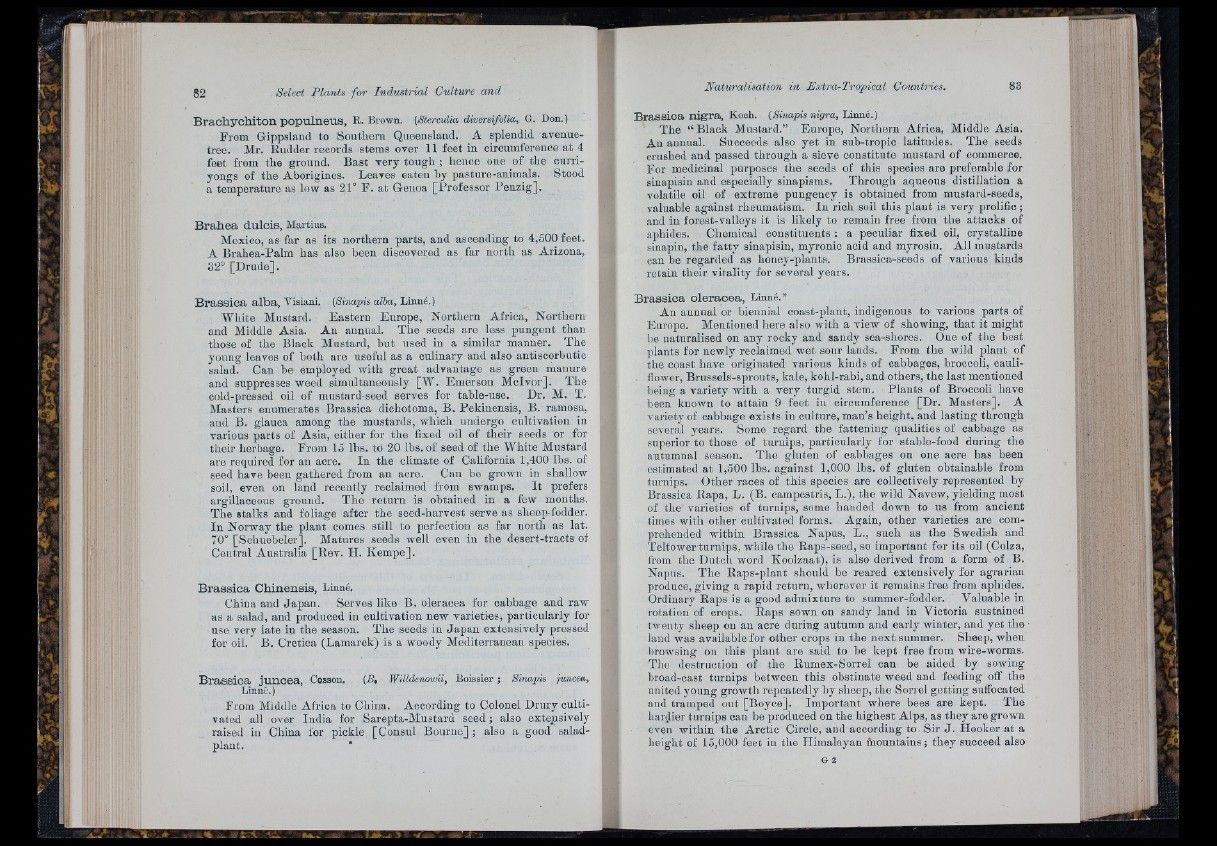
82 Select Plants fo r In d u stria l Culture and
B r a c h y o h ito n p o p u ln e u s , R. Brown. (Sterculia diversifolia, G. Don.)
From Gippsland to Southern Queensland. A splendid avenue-
tree. Mr. Rudder records stems over 11 feet in circumference at 4
feet from the ground. Bast very tough ; hence one of the curri-
yongs of the Aborigines. Leaves eaten by pasture-animals. Stood
a temperature as low as 21° F . at Genoa [Professor Penzig].
B r a h e a d u lc is, Martins.
Mexico, as far as its northern parts, and ascending to 4,500 feet.
A Brahea-Palm has also been discovered as far north as Arizona,
32° [Drude].
B r a s s ic a a lb a , Visiani. {Sinapis alba, Linné.)
White Mustard. Eastern Europe, Northern Africa, Northern
and Middle Asia. An annual. The seeds are less pungent than
those of the Black Mustard, but used in a similar manner. The
young leaves of both are useful as a culinary and also antiscorbutic
salad. Can be employed with great advantage as green manure
and suppresses weed simultaneously [W. Emerson Molvor]. The
cold-pressed oil of mnstard-seed serves for table-use. Dr. M. T.
Masters enumerates Brassica dichotoma, B. Pekinensis, B. ramosa,
and B. glauoa among the mustards, which undergo cultivation in
various parts of Asia, either for the fixed oil of their seeds or for
their herbage. From 15 lbs. to 20 lbs. of seed of the White Mustard
are required for an acre. In the climate of California 1,400 lbs. of
seed have been gathered from an acre. Can he grown in shallow
soil, even on land recently reclaimed from swamps. I t prefers
argillaceous ground. The return is obtained in a few months.
The stalks and foliage after the seed-harvest serve as sheep-fodder.
In Norway the plant comes still to perfection as far north as lat.
70° [Schuebeler]. Matures seeds well even in the desert-tracts of
Central Australia [Rev. H. Kempe].
B ra s s ic a C h in en sis, Linné.
China and Japan. Serves like B. olerácea for cabbage and raw
as a salad, and produced in cultivation new varieties, particularly for
use very late in the season. The seeds in Japan extensively pressed
for oil. B. Crética (Lamarck) is a woody Mediterranean species.
Coason. {B, Willdenowii,B ra s s ic a ju n c e a , Boissier : )uncea,
Linné.)
From Middle Africa to China. According to Colonel Drury cultivated
all over India for Sarepta-Mustard seed ; also extensively
raised in China for pickle [Consul Bourne] ; also a good salad-
plant. *
Naturalisation in Extra-Tropical Countries. 83
B r a s s ic a n ig r a , Koch. {Sinapis nigra, lArmé.)
The “ Black Mustard.” Europe, Northern Africa, Middle Asia.
An annual. Succeeds also yet in sub-tropic latitudes, The seeds
crushed and passed through a sieve constitute mustard of commerce.
For medicinal purposes the seeds of this species are preferable for
sinapisin and especially sinapisms. Through aqueous distillation a
volatile oil of extreme pungency is obtained from mustard-seeds,
valuable against rheumatism. In rich soil this plant is very prolific ;
and in forest-valleys it is likely to remain free from the attacks of
aphides. Chemical constituents : a peculiar fixed oil, crystalline
sinapin, the fatty sinapisin, myronic acid and myrosin. All mustards
can be regarded as honey-plants. Brassica-seeds of various kinds
retain their vitality for several years.
B ra s s ic a o le rá c e a , Linné.*
An annual or biennial coast-plant, indigenous to various parts of
Europe. Mentioned here also with a view of showing, that it might
be naturalised on any rocky and sandy sea-shores. One of tlie best
plants for newly reclaimed wet sour lands. From the wild plant of
the coast have originated various kinds of cabbages, broccoli, cauliflower,
Brussels-sprouts, kale, kohl-rabi, and others, the last mentioned
being a variety with a very turgid stem. Plants of Broccoli have
been known to attain 9 feet in circumference [Dr. Masters]. A
variety of cabbage exists in culture, man’s height, and lasting through
several years. Some regard the fattening qualities of cabbage as
superior to those of turnips, particularly for stable-food during the
autumnal season. The gluten of cabbages on one acre has been
estimated at 1,500 lbs. against 1,000 lbs. of gluten obtainable from
turnips. Other races of this species are collectively represented by
Brassica Rapa, L. (B. campestris, L.), the wild Navew, yielding most
of the varieties of turnips, some handed down to us from ancient
times with other cultivated forms. Again, other varieties are comprehended
within Brassica Napus, L., such as the Swedish and
Teltower turnips, while the Raps-seed, so important for its oil (Colza,
from the Dutch word Koolzaat), is also derived from a form of B.
Napus. The Raps-plant should be reared extensively for agrarian
produce, giving a rapid return, wherever it remains free from aphides.
Ordinary Baps is a good admixture to summer-fodder. Valuable in
rotation of crops. Raps sown on sandy land in Victoria sustained
twenty sheep on an acre during autumn and early winter, and yet the ■
laud was available for other crops in the next summer. Slieep, when
browsing on this plant are said to be kept free from wire-worms.
The destruction of the Rumex-Sorrel can be aided by sowing
broad-cast turnips between this obstinate weed aud feeding oif the
united young growth repeatedly by sheep, the Sorrel getting suffocated
and tramped out [Boyce]. Important where bees are kept. The
hardier turnips can he produced on the highest Alps, as they are grown
even within the Arctic Circle, and according to Sir J . Hooker at a
height of 15,000 feet in the Himalayan mountains; they succeed also
G2
ki ! t
' h <